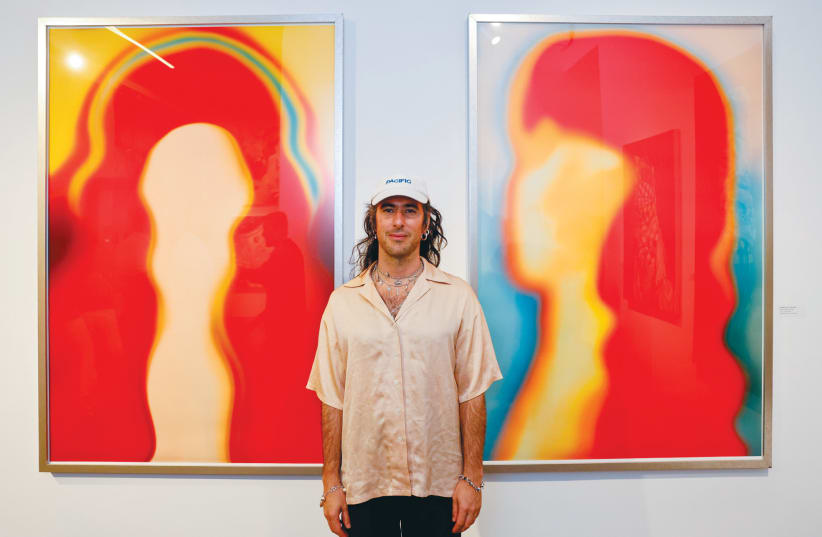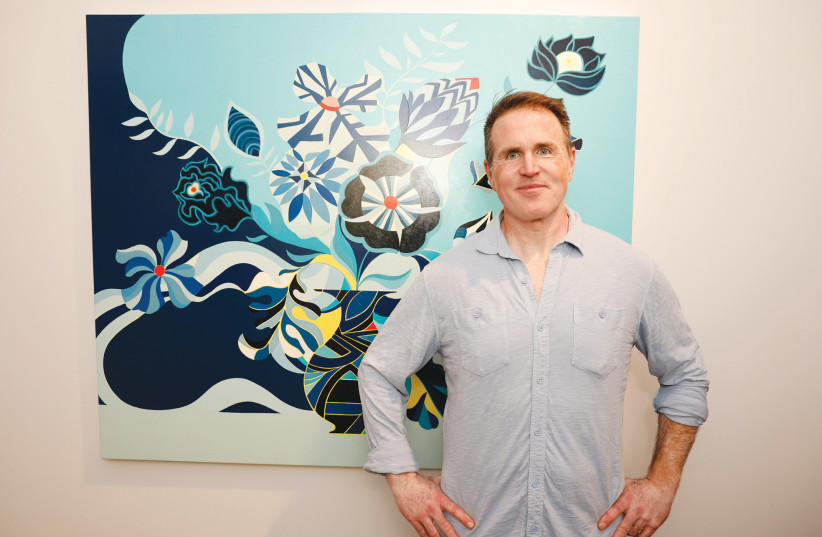‘I always try to see things from different perspectives. That’s why, often, the flowers within my paintings almost function like individual paintings within themselves,” says American painter Max Janson. “Sometimes they will be more geometric, other times more organic.”
Janson’s paintings, alongside those of other international artists, are currently on exhibit as part of the annual High Voltage exhibition in Tel Aviv.
High Voltage is the Nassima-Landau Foundation’s flagship exhibition, showcasing artists that founders Suzanne Landau and Steeve Nassima have identified as noteworthy and promising.
The exhibition is not only an opportunity for local art lovers and art collectors to see what is happening in the international art world, but also to be exposed to works by artists who have never exhibited here before. In its third year, featuring 17 artists and 40 new artworks (including sculptures), the exhibition introduces excellent artists, including a few who have already made quite a name for themselves in the fine-art international market.
Hailing from different countries and art genres, one thing is common to all of the works: They all generate a lot of heat and energy, and explode with vibrant colors and powerful imagery.
I met two of the artists who came over for the exhibition’s opening: Janson (b. 1974, New York City), and Australian photographer Francisco Tavoni (b. 1986, Caracas, Venezuela), who produces large-scale works that look like paintings.
I speak the language of everyone before me
“I am a painter,” says Janson, who uses both representational and abstract images while investigating the tradition of still-life painting. The painter explores this relationship in multiple ways, using timeless materials such as linen primed with lead, paint ground in aged oil and pigments, whose sources are hard to find.
“I was born and raised in a loft, in SoHo, in New York City,” he says. “I grew up surrounded by a community of artists who wanted to build their own society. I had a wonderful childhood in terms of the different people I came in contact with, different attitudes and approaches. That made a major impact on how I approach my work: more from a philosophical point of view.
“On Sundays, my father would set up still life for me to practice with watercolors,” Janson recalls. “I remember one time I was working on a still life of a pumpkin and candle, or something else he had set it up in front of one of his paintings. After I had done the majority of the painting, in the background I did his painting – so in some way, that way of thinking about something has continued in my work even until now: dealing with both the reality and the abstraction.
“Because I grew up around art, I am very informed in art history, paintings history in particular: going to museums as a child, seeing and being exposed to art, growing around my father’s abstract paintings and still life paintings,” he says. “So my work is, in a way, a homage to still life and to my father, who passed away many years ago. He did large-scale, abstract paintings. In some ways my first language was abstraction, so I almost saw the world through abstraction first and then the reality came second,” he explains.
“My paintings are very much informed. Although I use recognizable forms like flowers, I approach it through the lens of abstract. And I really like the play – when things are very recognizable and then they blur into something else.”
Janson believes in painting – he talks of brush strokes, of the use of old materials and old techniques, of noticing details and remembering everyone who came before him.
“To me, when you see the paintings, the presence of the hand is very important,” he says. “In this digital age, the slowness of painting and the acknowledgment of details is really important. I have a memory bank of images that I am drawing from as I paint. I speak the language of everyone before me; it is a language that every generation adds to in his turn.”
“I grew up surrounded by a community of artists who wanted to build their own society. I had a wonderful childhood in terms of the different people I came in contact with, different attitudes and approaches. That made a major impact on how I approach my work: more from a philosophical point of view."
Max Janson
Expressing philosophical and meditative traditions
In terms of artistic approach and inspiration, as well as medium and technique, Francisco Tavoni is on the other end of the artistic scale. But like Janson, he also uses philosophical terms when talking about his art.
The Australia-based photographer creates luminous portraits inspired by his spiritual experience and meditation, as well as his positive philosophy. Tavoni says he uses photography as a way to understand the power of affection, of love. “My work represents my beliefs, the way we understand inner identity versus what the outside world thinks: how the layers of external social conditioning play in that role.”
Tavoni creates color-saturated photographic images that are the result of film processes being manipulated in a new way, while using sheer, gauzy fabric, which obscures the details of his model, and generates a sense of warmth and spirituality.
“My dad was an Italian-born in Caracas,” he tells me. “I grew up by the beach. Caracas is a pretty wild place but very rich in culture, and chaotic, a lot like Tel Aviv. I feel at home here,” he adds with a smile. “I was very much into the culture of surfing and skateboarding. I grew up near the beach, and I still live by the beach. Surfing is still very much a part of my life.”
Tavoni fled Caracas when the political situation got hairy. “I was interested in skateboarding and surfing fashion. I knew all the photographers, and I could recognize the work of each one,” he says. “After I moved to Australia, I had a skateboarding and surfing fashion company and I did all the photography myself.”
The company did very well but Tavoni became more and more involved with the photography, and also with philosophical ideas that he learned from practicing yoga with his spiritual mentor.
“One time, we were doing a fashion shoot, and I decided that I wanted to cover the models with a transparent material. It had sparkling bits inside and, playing with the light, a pattern of dots emerged. I was fascinated,” he says. “I started playing with different fabrics and different lighting – putting light behind the model, lighting only the material, and not the model.”
TAVONI SEES his works as a way of expressing philosophical and meditative traditions. Utilizing his own lighting technique, the light, absorbed by the fabric, reveals its inner patterns. This unconventional lighting captures his signature style of abstracted images.
“Obscuring the details relates to what I believe is the essence of self: the soul that exists beyond the conventions of society. My works expand beyond daily interests,” he stresses.
In his works, Tavoni looks for authenticity, moving across different bodily shapes, regardless of gender, race or background. Veiled by delicate sheer fabrics, the human forms connect, unbound by identity. When lighted from behind, the human figure lacks the traditional identity representation, only to express his ideals: a world without boundaries and stereotypes that are imposed by society.
He creates only one print from each work. “I manipulate the lighting, reversing the image and pushing the photograph, but I do not process it afterwards. I do not use editing software or anything like that,” Tavoni says.
“I plan the set, I play with the lighting, the materials – the hair shape is very important for the silhouette – and the techniques I developed, and then I look for the frame that I like. Sometimes I get one frame from a shoot, and sometimes not even one good one.”
HV 3 – High Voltage Three, September 15 – November 15, 2022, Nassima Landau Gallery, 55 Ahad Ha’am Street, Tel Aviv. Entry free.

